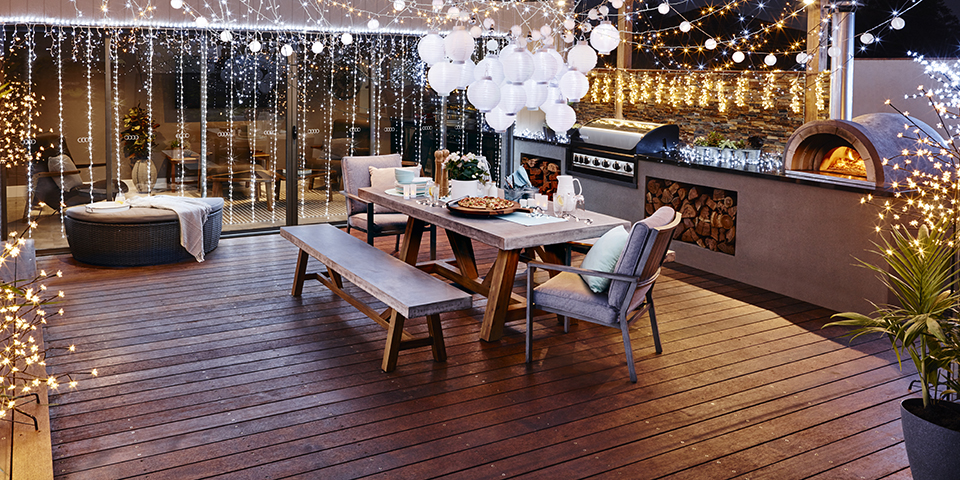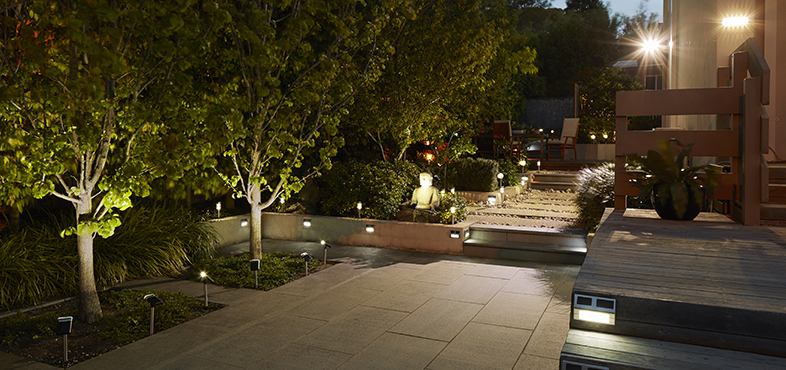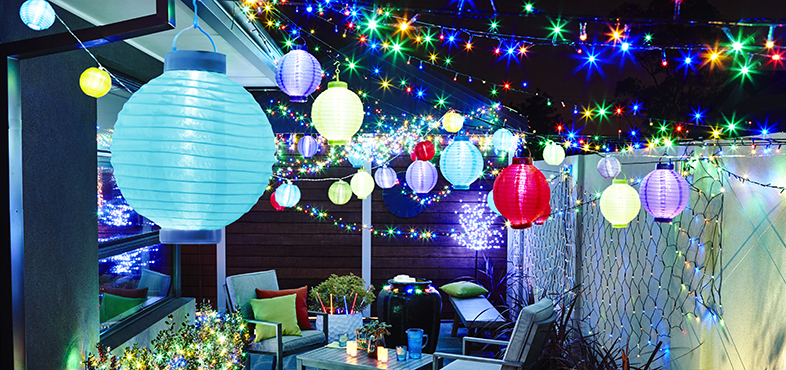Garden Lighting Guide
Garden lighting guide – how to choose lights for your outdoor space
Well-planned lighting can really enhance your outdoor space, increasing visibility in changing weather and creating atmosphere to extend your hours of enjoyment.
Getting started – make a lighting plan
Lighting can make or break your garden, so take time planning exactly what kind of illuminations you want and where.
Identify key features
Sketch a rough plan of your garden, marking all the key features. Identify which features you want to enhance – a pond, a tree, steps – and any that you might want to keep in the dark, like an old shed.
Think about how to create different lighting effects
Outdoor lighting should be fluid, with different types of lighting creating different effects across your garden
Downlighting is good for illuminating doorways, or throwing light onto a patio or decked area. Smaller downlights can pick out particular plants or features, while the smallest downlights attached to the bottom of low-level hardscaping like benches and windows define areas with a subtle, attractive glow.

What is Security Lighting & Why is it Important?
Outdoor lighting adds beauty and dimension to a home. Lighting is also an integral part of an effective home security system. Outdoor security lighting discourages would-be intruders from targeting your home by increasing the risk of being caught. The best lighting design allows physical detection and facial recognition, minimizes hiding spots, and increases your sense of safety.
You don’t have to light your home like a Christmas tree to feel safe. Over-illumination can draw unwanted attention to valuable items in your home or business and can cause light pollution. In this guide, we offer an overview of security lighting and simple tips to help you identify potential safety and security risks, select the best security lights, and determine their placement to ensure your safety and security.
THE PURPOSE OF OUTDOOR SECURITY LIGHTING
Andrew Coleman, a lighting designer for McKay Landscape Lighting in Omaha, NE, reveals the purpose of residential outdoor lighting is threefold. First, it must be aesthetically pleasing to the homeowners. Second, it must help the residents safely navigate the landscape and the perimeter of the home, and allow them to identify obstructions and potential hazards such as a change in elevation. Third, it must provide security by discouraging trespassers. A well-lit home is less likely to be broken into, he says.
TYPES OF SECURITY LIGHTS
When shopping for outdoor security lights, choose fixtures approved by the Underwriters Laboratories (UL) for wet or damp locations. These luminaries feature weatherproof designs and finishes capable of withstanding the elements such as humidity, rain, and snow
Flood Lights
Flood lights distribute a wide cone of light and are ideal for illuminating large spaces. The versatile fixtures come with one, two, or three adjustable heads for precise illumination.
Landscape Path Lighting
Landscape path lights are ideal for safely illuminating frequently used paths and walkways. The light fixtures are also suitable for illuminating trees and other architectural elements around your home

How to light your outdoors
The perfect plan
Before you start, it’s a good idea to make a plan. Begin by thinking about how you use your outdoor area and what the different lighting requirements are for each space. Perhaps you entertain a lot and would like a well-lit area, maybe you want to highlight a statue or water feature, or you may wish to create a relaxing atmosphere
Layer your lights
For spaces that have multiple uses, consider light layering. By layering your lighting you’ll be able to easily change the mood from tranquil to party with the flick of a switch. Whatever lighting style or mood you’re trying to achieve,
Ambient lighting
Ambient lighting should light up the entire space. In an outdoor area this could include a ceiling light, the light from a ceiling fan, a large spotlight, several downlights or well-spaced wall lights. Include a dimmer switch if possible for complete control.
Task lighting
Task lights do just what their name suggests – they illuminate areas where you are performing a specific task. For example, this may be a clip on BBQ light, down lights above a servery or a pendant hanging over a dining table.
Accent lighting
The role of accent lights is to provide a bit of theatre. These lights highlight the features that you want to stand out and can make a space feel warm and inviting. Accent lights could be used to focus on trees, a path or steps, an architectural feature or something in your garden like a pond. Think fairy lights, party lights, Japanese lanterns or decorative string lights (these come in all shapes and lengths).

All About Landscape Lighting
From selecting the best outdoor lights to setting them up, our experts share how to brighten up the outside of your house
You’ve pulled out all the stops to make your house and yard look first-rate. So why let that hard work disappear at nightfall. With a flick of a switch and some strategically placed outdoor house lights, you can roll back the darkness and put it all on display? Done right, landscape lighting makes the best of what you’ve got by highlighting your home’s architectural features and drawing attention to prized plantings and trees.
What is the Best Landscape Lighting?
Most landscape lighting today is low voltage, and with good reason. Unlike 120-volt systems, it’s safer to work with and less costly to install. And though low-voltage lights receive one-tenth the power, thanks to a step-down transformer, there’s no limit to the effects they can achieve, from ethereal moonlight beamed down from a tree canopy to a subtle glow that washes over a low garden wall. More than just picking the right hardware, a pleasing lighting scheme is also about artistry.
What’s in a Low-Voltage Outdoor Lighting System?
Landscape lighting typically relies on stepped-down power from your house.
Key Questions Answered
DIY or Hire a Pro?
Homeowners can put in a simple system in a weekend. For the most stunning effects, go with a landscape lighting specialist familiar with the various fixtures and ways to arrange them.
Tips for Protecting Outdoor Light Strings
Using outdoor light strings has become one of the most popular ways to illuminate outdoor spaces. You might have patio lights strung across your backyard or use dozens of Christmas light strings to build incredible displays during the holiday season. When installing your light strings, you should always make sure that they are as protected as possible from anything that can cause damage or electrical shorts. There are many ways to do this, so we will cover the most important tips. In this first part, we’ll discuss what strings and components are safe for outdoor use, when to cut light strings, and how to keep connections safe.
Use Outdoor Rated Strings
Before ever placing any light string outside, you should always check to make sure that the string is safe for outdoor use by looking at the safety rating. Rope light, patio light strings, and many Christmas light strings are safe for both indoor and outdoor use. Designed with sturdier materials, these lights can withstand the weather conditions. Some Christmas light strings, however, are only rated for indoor use. Using these lights outdoors can cause them to fail prematurely or even short out if they are exposed to water.
Don’t Use Old or Worn Strings
When was the last time you bought new light strings for your Christmas displays? If it’s been a while or your lights get stored in a hot attic for 10 or so months out of the year, chances are you might need some new ones. When you first get your lights out you should use testers to check for damaged sockets, bad bulbs, or blown fuses and make any necessary repairs. Strings with worn or brittle wires should be immediate thrown away as these lights can potentially pose a fire hazard.
Use Outdoor Rated Bulbs
While the majority of C7 and C9 bulbs are safe for outdoor use, the same cannot be said for other types of bulbs used in patio light strings. Incandescent bulbs are safe for outdoor use as long as they are protected from direct contact with water. If used in an open area, the lights should be taken down immediately after an event. Where and when LED bulbs can be used depends on the safety rating. Damp location rated bulbs can be used where moisture is present, but should not come in direct contact with water. LED bulbs with this rating should not be used for permanently installed light strings. Wet location rated bulbs can come in direct contact with water and can be safely used in open areas.
Only Use Outdoor Rated Extension Cords
Like the light strings themselves, extension cords must also be rated for outdoor use. Outdoor extension cords have thicker insulation designed to withstand wetter and rougher conditions. In order to verify if your cord is outdoor rated, you will need to check the ratings code stamped directly on the cord. Made up of letters, this code is used to describe what the cord jacket is made of and the conditions it can withstand. An outdoor rated cord will have a ‘W’ listed in the code.